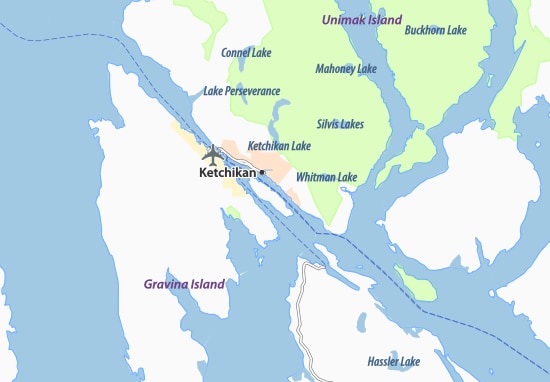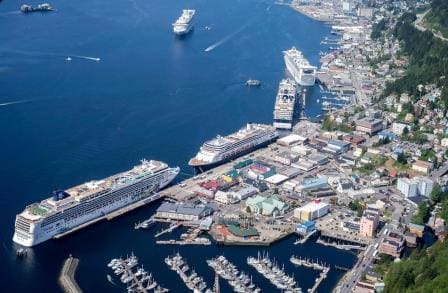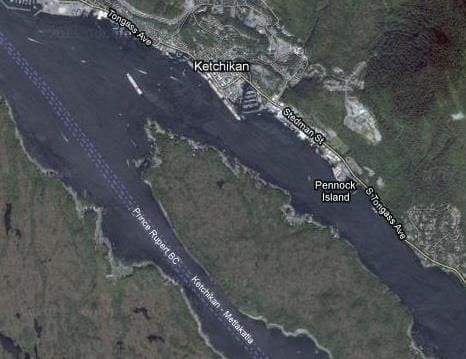We still had some good scenery while sailing through Grenville Channel but it was too misty to see any wildlife. Either they were obscured or the Bears, Moose and Goats decided to stay inside until it stopped raining. From The Triple Island Pilot Station it is only a short distance to reach the Twin Island pilot station in Alaska. We sail partly through Dixon Entrance and then hop over the border although nobody notices it. The only item of interest is that the clocks are going an hour back at 02.00 in the morning. We have been steadily moving west and Alaska is in a different time zone than Western North America. I suppose it makes a difference in the winter but with the long days here in the summer, you do not have to change the time to get more daylight here as we do in Europe. It is daylight from 3 am in the morning until 10 pm. in the evening and then the night hours are not really dark either. More of a sort of prolonged period of dusk or dawn.

We follow the route of the dotted line in the chart. The west side route past the island is more used by smaller ships and tugs and tows.
We boarded our pilot at 04.30 in the morning to make sure that we would be docked before 07.00 in the morning. We only have a short stay here, sailing again a 15.00 hrs. Ahead of us was the Grand Princess who had to dock first as she was on number three northbound, while we were scheduled for nbr 2 northbound. That gave a bit of a strange picture today as on berth nbr 4, we had a Princess ship docked for southbound and behind us on berth 1 we had the Silver Shadow docked for southbound as well. The latter only makes a few cruises to Alaska and was thus lucky to have a berth as it could have been taken up by one of the regular customers but not all ships have arrived in Alaska yet.
The approach to Ketchikan differs from all the other ports because it is such a long time of standby for everybody. This has to do with the fact that Ketchikan lays fairly well sheltered in the Tongass Narrows behind Pennock Island. I am saying fairly sheltered as the winter winds and rains can still blow fiercely through the area but it is more sheltered than other locations. Thus for arrival the troops on the bridge and on the mooring decks have to be in position once the ship start sailing through the east arm of Tongass Narrows keeping the island to the portside. This area is called Saxman village and because of the houses at the water’s edge, the docks and the USCG station the maximum speed is 7 knots to avoid wake. Then you have to slow down for the final approach to the dock and all in all, it takes over 90 minutes to get there. I am currently supervising and training the forward mooring deck crew and even with safety shoes on it is a chilly affair with cold feet on the steel deck, due to the weather being much chillier than it should be.

Stock photo Downtown Ketchikan, with cruise ships in port. We were at the spot of the blue hulled Holland America Line ship, only with the nose the other way around.
Because most weeks the ships docking are not the same, and thus not the same length, it means that when coming into position there is always an amount of “fiddling” going on to get the ship in the best spot. All focus is on the gangway location but we also have water breaks and sometimes a second gangway and they have to be clear of dock obstructions as well. Thus when we come in position and the Security Officer at the gangway has a final look, then quite often the call comes: “we have to go x feet or x inches forward or aft”. Long time ago I indeed heard the Security Officer demanding that the bow had to go 2 feet forward and the stern 3 feet aft. He had to take stick for that for a long time. We were docked fairly quickly today as we only needed to focus on the gangway location.
We sailed at 3 pm. and moved north. Due to the return of the tours we just made it on time as we had to leave on time, as it is a tight schedule to get on time to Juneau. We are scheduled to be docked at 10. am. but the captain would like to be a little bit earlier to help the tours get on the way.
Weather for tomorrow, more of the same, but maybe a bit more clear skies.


June 21, 2017 at 5:40 pm
Oh yes. watched your ship arrive on the Ketchikan Webcams – 4 very clear views. Noticed Grand Princess is now sporting hull art. See ya in Juneau.